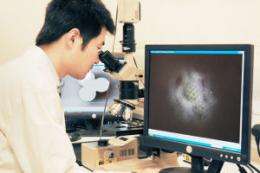Microscope could 'solve the cause of viruses'

(PhysOrg.com) -- University of Manchester scientists have produced the world’s most powerful optical microscope, which could help understand the causes of many viruses and diseases.
Writing in the journal Nature Communications, the team have created a microscope which shatters the record for the smallest object the eye can see, beating the diffraction limit of light.
Previously, the standard optical microscope can only see items around one micrometre – 0.001 millimetres – clearly.
But now, by combining an optical microscope with a transparent microsphere, dubbed the 'microsphere nanoscope', the Manchester researchers can see 20 times smaller – 50 nanometres (5 x 10-8m) – under normal lights. This is beyond the theoretical limit of optical microscopy.
This hugely-increased capacity means the scientists, led by Professor Lin Li and Dr Zengbo Wang, could potentially examine the inside of human cells, and examine live viruses for the first time to potentially see what causes them.
The existing microscopes which have the capacity to examine tiny items – electron microscopes – can only see the surface of a cell rather than examining its structure and there is no tool to see a live virus visually.
The scientists, from the School of Mechanical, Aerospace and Civil Engineering, now believe they can use the microscope to detect far smaller images in the future. The new method has no theoretical limit in the size of feature that can be seen.
The new nano-imaging system is based on capturing optical, near-field virtual images, which are free from optical diffraction, and amplifying them using a microsphere, a tiny spherical particle which is further relayed and amplified by a standard optical microscope.
Professor Li, who initiated and led the research in collaboration with academics at the National University and Data Storage Institute of Singapore, believes their research could prove to be an important development.
He said: "This is a world record in terms of how small an optical microscope can go by direct imaging under a light source covering the whole range of optical spectrum.
"Not only have we been able to see items of 50 nanometres, we believe that is just the start and we will be able to see far smaller items.
"Theoretically, there is no limit on how small an object we will be able to see.
"The common way of seeing tiny items presently is with an electron microscope, and even then you cannot see inside a cell – only the outside. Optical fluoresce microscopes can see inside the cells indirectly by dying them, but these dyes cannot penetrate viruses.
"Seeing inside a cell directly without dying and seeing living viruses directly could revolutionize the way cells are studied and allow us to examine closely viruses and biomedicine for the first time."
Among other tiny objects the scientists will be able to examine are anodized aluminum oxide nano-structures, and nano-patterns on Blue-Ray CVC disks, not previously visible with an optical microscope.
More information: Optical virtual imaging at 50 nm lateral resolution with a white light nanoscope, by Zengbo Wang: Nature Communications (2011)
Provided by University of Manchester














